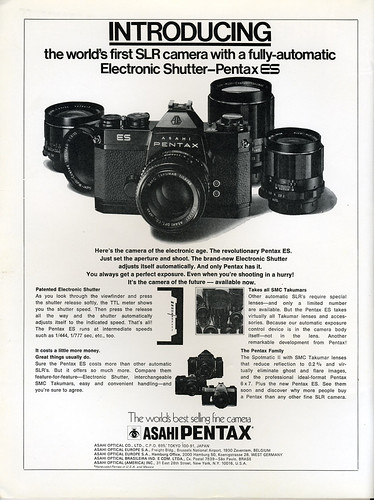Pentax ES
| ||
|
The Pentax ES was announced by Asahi in 1971,[1] as the world's first SLR with 'fully-automatic electronic shutter'.[2] It offers what has since become familiar as aperture priority automatic exposure (shutter priority AE was already possible with other cameras, such as the Canon F-1, at this time). Electronic shutter timing makes aperture-priority AE possible because it allows the shutter speed to be essentially continuously variable, not restricted to whole or half-stop values. Manually-set shutter speeds on the ES are mechanically timed, however (and so not dependent on the camera battery, so the camera is fully operable (though without metering) at all normal hand-held speeds, in the event of battery failure). The ES also makes an early use of a memory circuit in exposure control, to store the exposure setting in the brief period of 'blackout' when the mirror is moved to allow exposure.
Asahi [3] emphasised the advantage that, since the mechanisms involved in this mode of AE were in the camera body, not the lens, the camera could be used, in AE, with almost all existing Takumar lenses (in contrast, shutter-priority systems like Canon's had required the development of new lens mounts incorporating rapid stop-down mechanisms).
Sadly, McKeown describes the ES as unreliable.[4]
Specifications[3]
Camera type: 35 mm SLR camera with TTL metering and aperture-priority AE
Lens mount: 42mm thread (Pentax screw mount)
Standard lens: 55 mm f/1.8 or 50 mm f/1.4 SMC[5] Takumar; (the Super Takumar lenses of the same length and aperture do not fit).
Shutter:
- Horizontally-running focal plane shutter with electronic or mechanical timing
- In AE, shutter speed is continuously variable from 8 seconds to 1/1000 second
- Mechanically timed shutter speeds 1/60 - 1/1000 second and 'B' can also be set manually
- No delayed action
- Shutter cocked by advancing the film (shutter-cocked indicator: red dot in window next to shutter release)
Metering:
- CdS Through-the-lens meter. Usable in full-aperture AE or stopped-down metering.
- Sensitivity EV 1-18 at ISO 100.
- Exposure compensation -1 to +2 stops offset possible (dial around rewind crank)
- Film speeds ISO 20-1600 can be set (dial around rewind crank)
Flash synchronisation: Hot shoe (synchronised for X-synch. at 1/60 sec) and separate PC sockets beside lens mount for X- and FP-synch.
Viewfinder:
- Pentaprism viewfinder.
- Fresnel focusing screen has a central microprism focusing aid.
- Meter scale at right hand side shows shutter speeds 1-1/1000 second.
Film advance: Single-stroke winding lever.
Film rewind: folding crank; rewind release button on base.
Depth-of-field preview (and stop-down for stopped-down metering): lever to left of lens mount to be used in preference to the lens' stop-down lever.
Dimensions (width x height x depth): 143 x 98 x 91 mm (presumably with standard lens fitted)
Weight: 940 g (presumably with standard lens fitted)
Battery: One 4SR44/PX28A 6V silver oxide battery. Battery compartment to the right of the lens mount.
Battery check button next to rewind crank (meter needle should fall below 1/30 sec mark)
Notes
- ↑ According to Pentax Imaging (archived); McKeown dates it to 1972; probably the difference between announcement and actual availability.
- ↑ Pentax Imaging (archived) states more explicitly that the ES was the world's first SLR with through-the-lens aperture-priority AE.
- ↑ 3.0 3.1 User's Manual for the ES (pdf) at Pentax Imaging
- ↑ McKeown, James M. and Joan C. McKeown's Price Guide to Antique and Classic Cameras, 12th Edition, 2005-2006. USA, Centennial Photo Service, 2004. ISBN 0-931838-40-1 (hardcover). ISBN 0-931838-41-X (softcover). p.80.
- ↑ Super Multi-Coated.

